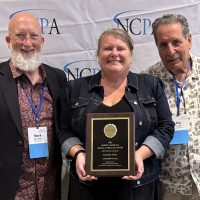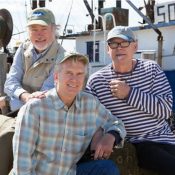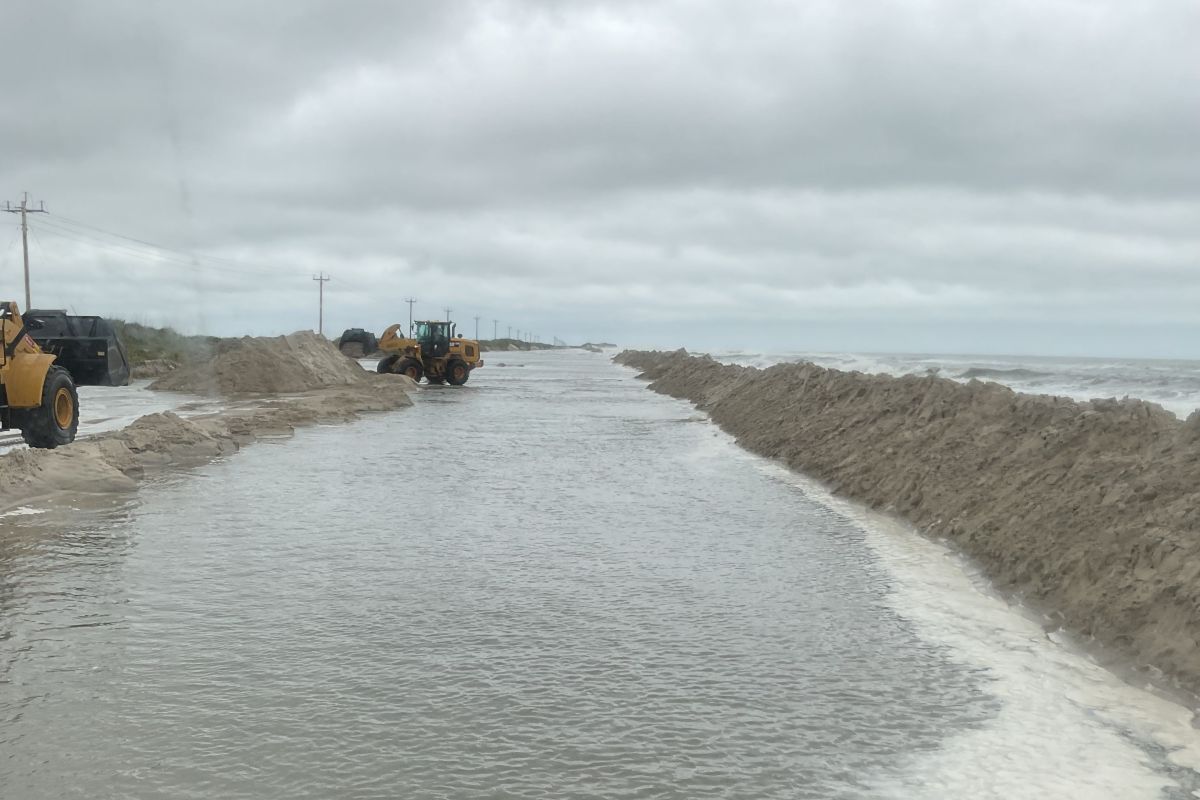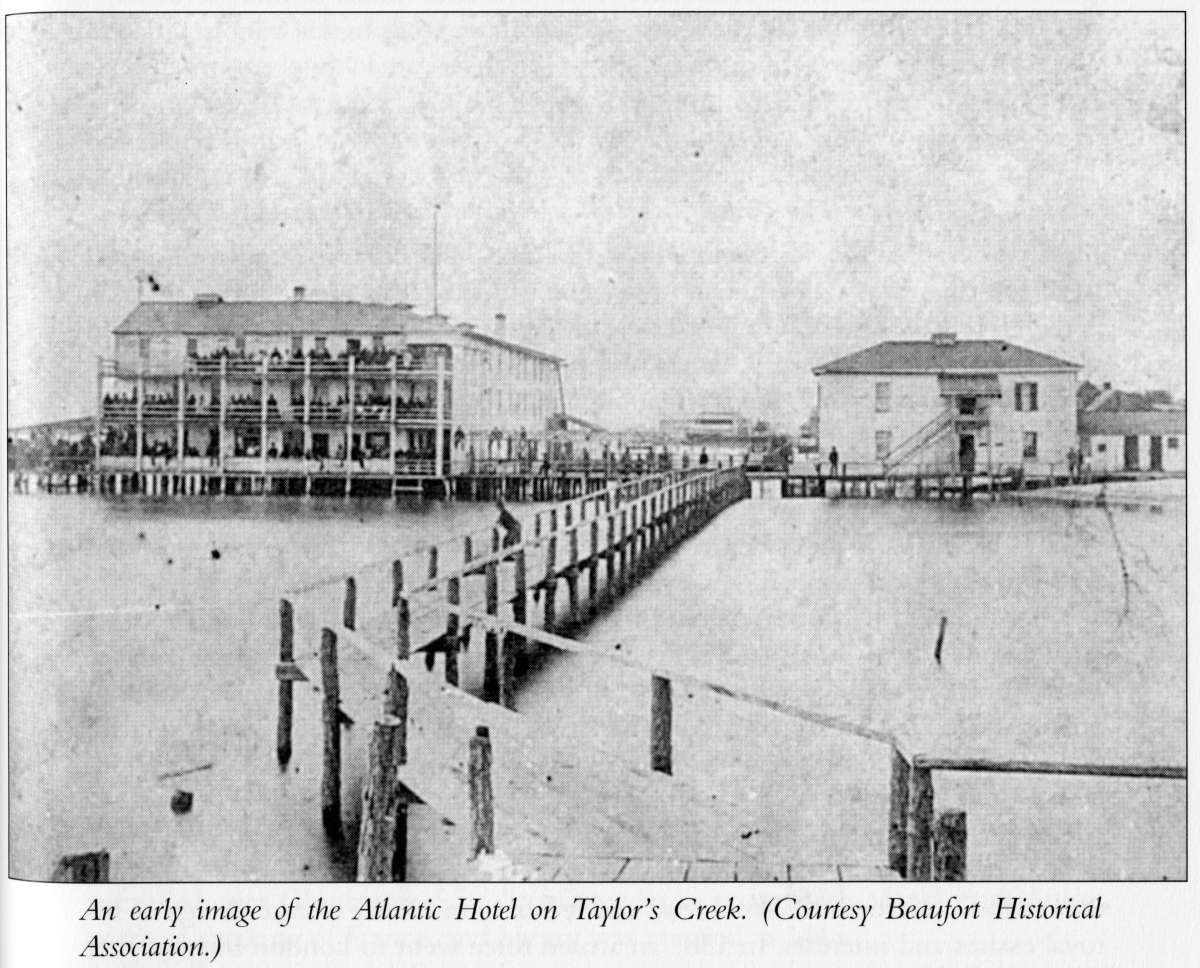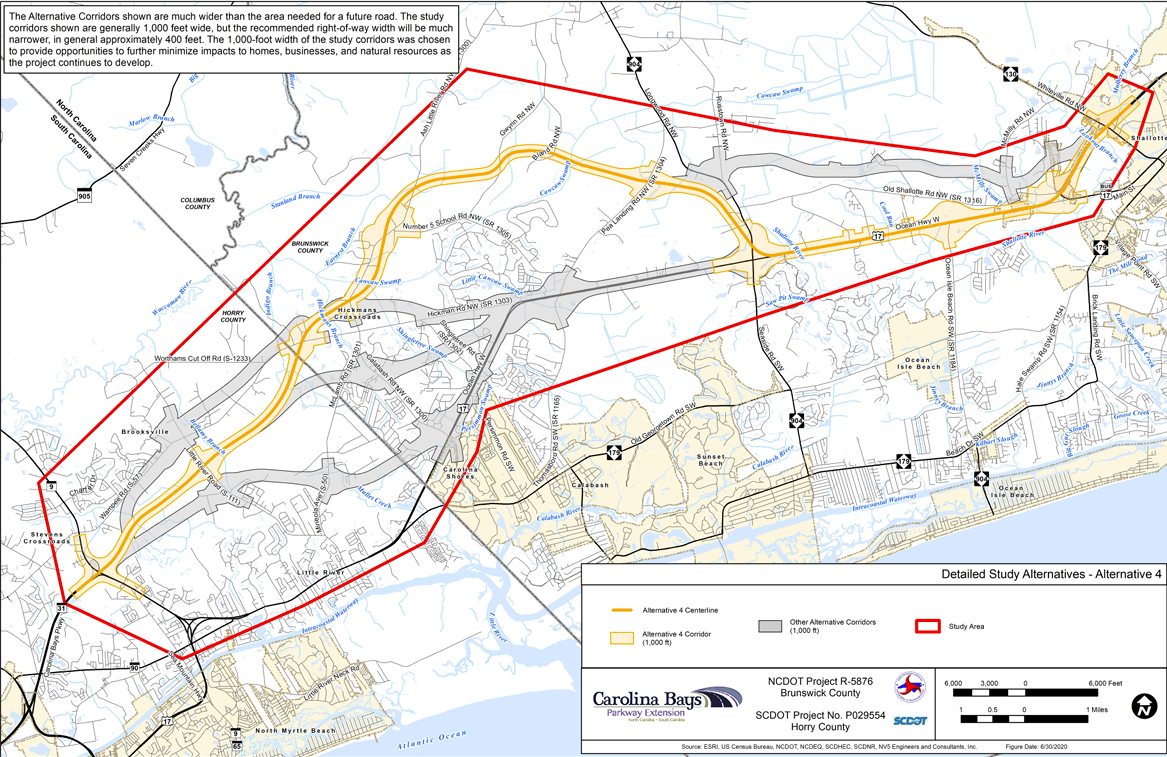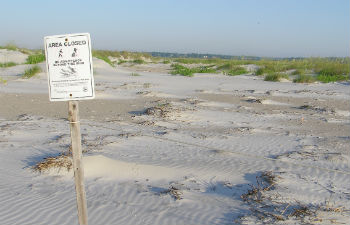 Stakes with twine and signs like this one designate Mason Inlet Waterbird Management Areas, which protect the nesting grounds of migratory shorebirds like least terns and piping plovers. Photo: Audubon North Carolina |
WRIGHTSVILLE BEACH — New Hanover County is back in compliance with its federal permit after failing to adequately maintain shorebird habitat at relocated Mason Inlet, but a 30-year commitment to monitor birds there may be coming to an end.
Until late last week, the county had not been keeping up with clearly marking and maintaining fenced areas at the north end of Wrightsville Beach, federal officials said.
Supporter Spotlight
As of July 10 the “issue has been addressed to our satisfaction,” said Dale Beter, the chief of the Army Corps of Engineers’ office in Wilmington.
Under the terms of the Corps’ permit, issued in 2001 and coordinated by U.S. Fish and Wildlife Service, the county is responsible for managing and monitoring migratory shorebirds on the north and south ends of Wrightsville Beach and the south end of Figure Eight Island.
The county undertook that job as part of the federal permit to move the channel in Mason Inlet about 3,000 feet north to save condominiums and other property threatened by erosion. The inlet was moved in 2002 after years of debate, much of which centered on the birds that forage and nest in the inlet.
The county earlier this year was granted permission by the federal agencies to cease bird monitoring, a stipulation the county has asked to be removed from the permit. The county is still required to manage the area.
“We allowed them to stop reporting the number of birds and eggs on the north end while we are going through this modification process,” said Kathy Matthews, a biologist with the U.S. Fish and Wildlife Service. “The issues with management began this spring. There have been times when things haven’t been posted appropriately.”
Supporter Spotlight
The two federal agencies have been working with the county to rectify the matter.
“Typically with a noncompliance issue of any sort we give the permittee the opportunity to come into compliance,” Beter said. “There’s an opportunity to take action before we go further with a more formal penalty or administrative action. We’ve been dealing with this informally.”
One of the consequences of being out of compliance is permit suspension or revocation, but because the county asked more than a year ago to revisit the permit conditions, the Corps has been taking a more “informal” approach to the noncompliance issue, Beter said.
“We’ve been kind of operating under that consultation process by having them address these issues,” he said.
Corps and Fish & Wildlife officials will meet within the next two weeks to discuss the county’s request, Beter said.
In addition to dropping migratory shorebird monitoring requirements, the county has also asked to no longer monitor small invertebrates that live in the sand, such as clams and worms. They county also wants to be relieved of any responsibility of relocating the shorebird protection area in conjunction with erosion.
 Layton Bedsole |
“Historically the line of demarcation has moved,” said Layton Bedsole, New Hanover County’s shore protection coordinator. “It has gone from a period of nesting to a period of non-nesting and so the line has moved back and forth on site. We’re proposing a more robust year-round alignment, which we hope will eliminate moving that line back and forth every year. We have a proposed approach where we would like to go from tobacco stakes and twine to something more substantial that would be more obvious and perhaps better inform the public of our goals of protecting that area for bird usage.”
The county’s proposal includes staking the area with four-by-four wooden posts, larger than the two-by-two stakes that are there now, and a thicker rope.
Bedsole declined to discuss in detail all of the modifications the county wants to see made, saying he does not want to publicly negotiate terms of the contract.
The county came out of compliance when the eastern leg of the marked area washed out and the dune line was demarcated by the tide.
“The area in question now is a very ephemeral area that changes with every tide,” Bedsole said. “The question is, where does the project end? The birds don’t know there’s a string there. They just know that the habitat’s there.”
A county official has visited the area “about ever other Friday,” he said. One hundred new signs have been purchased to mark the area. The county recently reached an agreement with Wrightsville Beach to patrol the area several times a day, Bedsole said.
Audubon North Carolina for years was contracted by the county to manage and monitor shorebirds at the inlet. The county did not renew its contract with Audubon last year and in October 2013 assumed the responsibility.
“We left it in good condition,” said Lindsay Addison, a biologist with Audubon North Carolina. “Postings are really simple, really easy things to do. In order to adjust the postings would probably take me about an hour. It has to be checked on a regular basis.”
Audubon continues to conduct shorebird surveys at the inlet on a weekly basis, she said. Last fall, surveyors noticed strings had broken from posts marking the area. By early January, a “large portion” of postings were down, Addison said.
 A baby least tern camouflages with the sand. In May, Audubon surveyors counted four nests and 70 to 75 pairs of least terns in the area. |
In early May, 70 to 75 pairs of least terns were counted in the area. On May 27, Audubon surveyors counted four nests, two inside the posted area and two outside of the marked habitat, Addison said.
Inlets provide vital, sandy havens to migratory shorebirds. These areas are ideal nesting habitat for birds like the terns, she explained. Inlets are a good food source for birds and these areas are essential rest stops for migrating birds.
Protecting, maintaining and monitoring water birds in these areas are crucial, said Walker Golder, Audubon North Carolina’s deputy director.
“The monitoring component is essential,” he said. “Without it you don’t know where the birds are nesting. You don’t know where the signs need to be. It’s the only way to know whether what you’re doing is really working or not.”
Matthews said her office presumed the county was managing the north end of Wrightsville Beach through the fall and winter.
“We assumed that they were, but we didn’t go down there to check and we didn’t have any complaints,” she said.
Fish and Wildlife officials last checked the area June 24 and it looked good, she said. During that visit federal officials made some recommendations to the county to take additional measures.
“We may ask them to send us an annual report detailing their activities,” Matthews said.
The Corps will rely on Fish and Wildlife’s expertise to determine what modifications to make to the permit, Beter said.
“A 30-year monitoring requirement may be somewhat excessive,” he said. “Our position is that the Corps is willing to entertain relief from some of the monitoring only after some coordination with the Fish and Wildlife Service.”

